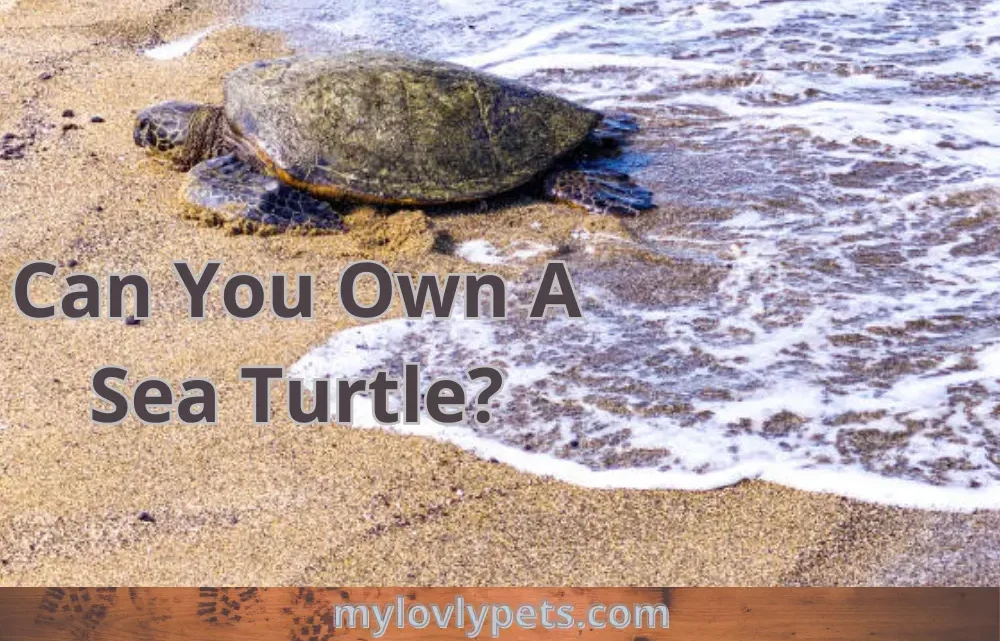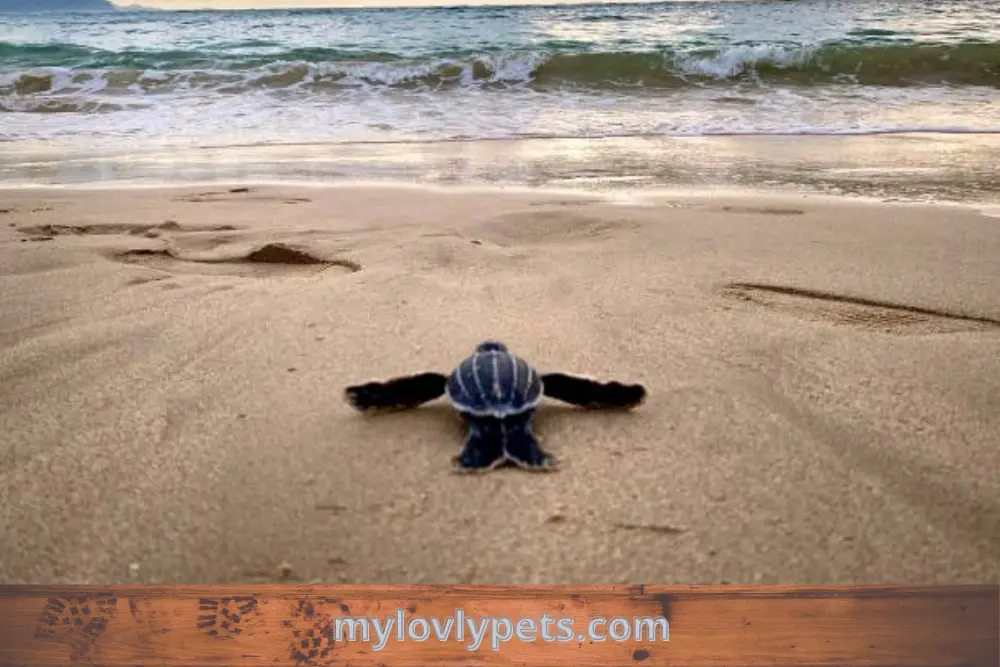
Can You Own A Sea Turtle? Amazing Facts
Can you own a sea turtle? Despite their cuteness, you cannot own a sea turtle as a pet.
Trading or possessing sea turtles in the United States is illegal due to the ESA protecting endangered species. There are seven different types of sea turtles, all considered critically endangered in the United States.
To improve the probability of survival, the government has banned the sale or possession of sea turtles. According to the law, finding a sea turtle in your backyard can result in fines of over $20,000 and a prison sentence of up to 6 months. But the poaching and trafficking of sea turtles is still an issue.
Can You Own a Sea Turtle?
If you encounter an injured sea turtle, you can legally take it into your possession to provide first aid. But the species has specific environmental needs that are hard to recreate at home. Sea turtles develop faster than any other turtle, and even the Kemp’s Ridley’s turtle, the smallest subspecies, has a carapace length of 20 to 29 inches. The average size of a marine turtle is 2.5 to 4 feet. A 40-gallon tank can keep a marine turtle temporarily.
Can We Keep Sea Turtles at Home?

In their natural habitat, sea turtles can be found at the ocean’s surface and great depths. They can hold their breath for 4 to 7 hours at a time, so giving them a big place to live will be essential in a few months.
While sea turtles can get all the nutrients they need from the salty ocean water, they prefer to avoid coming ashore unless crucial. The temperature and water pressure in the middle of the ocean differ from what they are on land, so marine turtles can never get used to their enclosures, no matter how well they are set up.
Trading or possessing sea turtles is illegal in the United States due to the Endangered Species Act (ESA). Six out of the seven sea turtle species in the United States are considered critically endangered. However, if you are helping a sea turtle recover from an injury, you can keep it as a pet in some states. However, no one should ever buy or sell a sea turtle as a pet. Aquatic turtles are not the same as sea turtles, although regular turtles are approved for sale at pet stores.
Aquatic turtles make wonderful pets if you can provide the proper care for them. To ensure that your turtle doesn’t feel lonely, we advise you to acquire more turtles. Please refer to the appropriate reference manual for more information about housing options and related topics.
Unbounded Space
An aquarium with at least 40 gallons of space is required for a single sea turtle and, ideally, more. A minimum of 40 gallons of tank space is required for a single adult turtle, 80 gallons for a pair of turtles, and so on.
Baby turtles don’t need as much room, but they will grow, so they should buy a giant aquarium. At an average of 2.5 to 4 feet in length, this species matures more rapidly than any other turtle on Earth. It is suggested that the water level in the aquarium be raised to about halfway, creating a surface area where the turtle can come up for air.
The substrate can be anything from coconut husks, potting soil, small pebbles, and sand. Because sea turtles are born explorers, they require a large environment within a few months.
Water Conditions
The water in which sea turtles live is salty and has all the minerals they need. Most of the time, they swim in the water. Sometimes, they come to the top to get air and dive back into the ocean. Since the water pressure and relative humidity at sea differ from land, sea turtles must be housed in a non-chlorinated aquarium.
Remember that turtles will urinate and defecate in the water, so you must clean and filter it regularly.
A water filter and an extra tank should be in place before you bring home a sea turtle as a pet. Sea turtles need water like we need air and can’t live without it for too long. They can breathe regular air through their noses but must have constant access to water. Keep the turtle in the other aquarium while you clean the first.
Adequate Nutrition
Food sources for sea turtles range from seagrass and other seaweeds to jellyfish, snails, and even algae. As they become adults, they transition to a more vegetarian diet but remain omnivores.
However, if swallowed, plastics are a leading cause of death for sea turtles because they can cause internal organ ruptures and intestinal obstructions. It is estimated that over 52% of all sea turtles worldwide have ingested plastic debris at some time. Jellyfish are a staple food for turtles since they are easy prey and provide a high-quality nutritional meal.

There are seven kinds of sea turtles, each with specific dietary needs. Sea turtles include Flatback Turtles, Green Turtles, Loggerhead Turtles, Olive Ridley Turtles, Kemp’s Ridley Turtles, Leatherback Turtles, and Hawksbill Turtles.
While Green Turtles eat plants, Flatback Turtles eat both plants and animals. The Olive Ridley Turtle is a vegetarian, while the Loggerhead Turtle is a carnivore. Only meat will satisfy a Kemp’s Ridley Turtle. The Hawksbill Turtle is a picky eater, while the Leatherback likes gelatin. The effects of plastic pollution on marine life have been severe, especially for sea turtles.
Journeys of the Turtle
Sea turtles travel quite far between their breeding and feeding grounds. The average distance the Leatherback travels is 3,700 miles. Sea turtles mate at sea and then return to land to lay their eggs. Female leatherback turtles go ashore to lay their eggs (up to a hundred at a time), which they then cover up and return to the ocean.

It takes roughly 60 days for a turtle egg to develop, and then the small hatchlings must brave the nighttime journey from the nest to the water, where they are vulnerable to being eaten by seabirds, crabs, and other predators. Coastal expansion is a further concern. The hatchlings follow the horizon’s natural light to the sea. The turtles can be misguided by the lights of hotels, homes, and other structures.
Can You Have a Baby Turtle as a Pet?
It is against the law to keep an adult sea turtle or a hatchling as a pet because the species is still endangered, and hatchlings are particularly vulnerable. A mother sea turtle can lay more than 100 eggs per nesting season, and even if a hatchling makes it to the sea, there is no assurance it will survive.
Baby sea turtles are still sea turtles, so they are just as threatened as adults. If you encounter a baby sea turtle on the beach or in some other inaccessible area, you should return it to the ocean and let it go free.
If you encounter a sick or damaged baby sea turtle, you can bring it home and provide it with the care it needs to recover. However, they will remain on the endangered species list unless humans stop hunting them and dumping plastic into the ocean.
Can You Buy Sea Turtles?
It is illegal to trade or sell sea turtles. To lessen the threat to this species’ survival, the Convention on International Trading in Endangered Species of Wild Fauna and Flora (CITES) has outlawed the trading of sea turtles or any part of them. This is because of the rapid decline in their population and the high demand for them on the black market.
Poaching is a severe threat to marine turtle populations globally because of the high demand for marine turtle eggs and flesh in luxury restaurants. The legislation aims to reduce the risk of extinction for this species.
Can You Touch a Sea Turtle?
No, you cannot touch a sea turtle. Feeding, caressing, or harassing sea turtles is illegal under the Endangered Species Act. Sea turtle harassment is forbidden on all islands and beaches. Depending on severity, harassing marine turtles or wildlife is a civil or criminal offence.
Moreover, Sea turtles can carry harmful bacteria and parasites that can make people sick. These may be spread directly while caring for the turtle or cleaning its tank or indirectly, through contact with polluted water or surfaces.
What Kind of Turtle Can You Have as a Pet?
Do your research before deciding on a species and gender of turtle to call your own because even baby turtles can grow to the size of a trash can lid. In many species, females get much bigger than their male relatives.
The finest species are male red-eared sliders, male painted turtles, and male U.S. mud and musk turtles.
Can You Legally Own a Sea Turtle?
Keeping a sea turtle as a pet is a federal violation. The state can charge up to $20000 or give you six months in jail if they find a marine turtle in your possession. Sheltering a marine turtle for a few days to heal is legal. The state bans keeping marine turtles as pets since the species is at risk of extinction. Poaching, illegal trade, and destruction of sea turtle habitats all affect the population of this endangered species.
If the government permits pet ownership, the marine turtle population will quickly decline to extinction. A person who discovers an injured sea turtle may temporarily hold the animal while it recovers, but he must seek professional advice before doing so.


